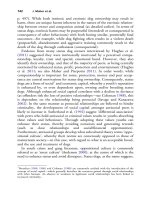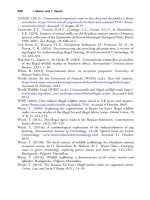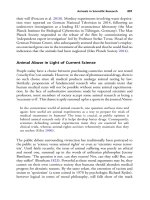The palgrave international handbook of a 133
Bạn đang xem bản rút gọn của tài liệu. Xem và tải ngay bản đầy đủ của tài liệu tại đây (37.03 KB, 1 trang )
Animal Hoarding
123
As a widespread, severe and complex form of animal cruelty, there are no
easy solutions to animal hoarding. Despite continued barriers to effective
community coalitions to address hoarding there are many steps that can be
taken to overcome these obstacles (Patronek et al. 2006). In addition,
society’s view of animal hoarding continues to evolve; it is promising that
it is increasingly seen as a serious human and animal welfare issue that
requires entire communities to respond effectively. Hopefully, the future
will bring more information on the genetic, environmental, demographic,
neurocognitive and neural substrates of animal hoarding leading to better
informed interventions for the benefit of all involved—both human and
non-human (Patronek and Ayers 2014).
References
American Psychiatric Association (2013). Diagnostic and statistical manual of mental
disorders. Arlington, VA: American Psychiatric Publishing.
Anonymous (1875, February 12). A home for indigent cats. Eight mousers quartered in an east side tenement. New York Sun.
Arkow, P., & Lockwood, R. (2013). Defining animal cruelty. In C. L. Reyes &
M. Brewster (Eds.), Animal cruelty: a multidisciplinary approach to understanding
(pp. 3–24). Durham, NC: Carolina Academic Press.
Arluke, A., Frost, R., Steketee, G., Patronek, G., Luke, C., Messner, E., et al.
(2002). Press reports of animal hoarding. Society and Animals, 10, 113–135.
Avery, L. (2005). From helping to hoarding to hurting: when the acts of ‘good
Samaritans’ become felony animal cruelty. Valparaiso University Law Review,
39(4), 815–858.
Beetz A., Uvnäs-Moberg, K., Julius, H., & Kotrschal, K. (2012, July 9). Psychosocial
and psychophysiological effects of human-animal interactions: the possible role of
oxytocin. Front Psychology, 3, 234. doi:10.3389/fpsyg.2012.00234. eCollection
2012.
Benniston, G. (2015, July 29). The state of sheltering. Forth Worth Magazine.
Bernstein, M., & Wolf, B. M. (2005). Time to feed the evidence: what to do with
seized animals. Environmental Law Reporter, 35(10), 10679.
Berry, C., Patronek, G. J., & Lockwood, R. (2005). Animal hoarding: a study of
56 case outcomes. Animal Law, 11, 167–194.
Boat, B. W., & Knight, J. C. (2001). Experiences and needs of adult protective
services case managers when assisting clients who have companion animals.
Journal of Elder Abuse and Neglect, 12(3–4), 145–155.
Bloch, M. H., Bartley, C. A., Zipperer, L., Jakubovski, E., Landeros-Weisenberger,
A., Pittenger, C., et al. (2014). Meta-analysis: hoarding symptoms associated









